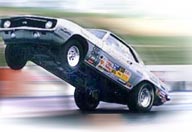
wayne@racingnetsource.com
 |
 |
Ramblings About Fate and Today's Stock Eliminator
4/8/04
![]() itting in my shop (and stripped
to the bone, bolted to my rotisserie) is a pretty nice 1970 Nova. The car had
just over 35,000 miles on it when I blew it apart. It's your typical little
old lady sled - original, sprayed by Fisher Body lacquer paint, some minor parking
lot rash, zero cancer and the only factory option is power steering. It's so
plain, it makes a vintage Road Runner seem positively luxurious. The original
plan was to turn it into a nice street machine - paint and detail it, maybe
install a big block crate motor, and drive it. Then fate intervened.
itting in my shop (and stripped
to the bone, bolted to my rotisserie) is a pretty nice 1970 Nova. The car had
just over 35,000 miles on it when I blew it apart. It's your typical little
old lady sled - original, sprayed by Fisher Body lacquer paint, some minor parking
lot rash, zero cancer and the only factory option is power steering. It's so
plain, it makes a vintage Road Runner seem positively luxurious. The original
plan was to turn it into a nice street machine - paint and detail it, maybe
install a big block crate motor, and drive it. Then fate intervened.
The NHRA, in all of their wisdom, decided to "enhance the Sportsman Racer's experience". That meant some National events would effectively lose categories - as we all know, rotated out one year and back in another. So if you had, for example, a SS car, you might be able to race at say, Phoenix one year, but not the next. Plenty of folks were (and still are) bummed out. I would be too if the event was in my back yard, and I had a $75,000 SS car parked in a trailer waiting to race.
Some astute racers figured something out. Over the years, the index system for both Stock and Super Stock has actually become pretty soft. In fact, some seasoned veterans can probably remember when the indexes were actually tougher in days of yore than they are today. Given today's index system, it is possible to run something like a Stocker in Super Stock, and go-rounds. Radial tires have helped, but so have the more liberal rules in place for Stock Eliminator. Look at it this way: A 1970 Nova with a 375 (400 factored) HP 402 is a natural B/Stock Automatic combination. The same combination in SS (395 factored) is a natural Super Stock/F Automatic combination. It can also fit in SS/GA. Now, the index in B/SA is 11.55 while the index in SS/FA happens to be 10.75. SS/GA is 10.85. Seems like a stretch, until you figure in the fact that plenty of strong B/SA cars can run 10.30's all day long - that's almost a half second under for SS, and more than competitive.
What's needed for a Stocker to make the SS program is a full roll cage and a window net. That's the reason why so many new Stockers are getting "legal" roll cages (or why so many older Stock Eliminator cars were retrofitted with cages over the past winter). The bottom line here is, a decent Stocker can run SS pretty easily, particularly when you figure the real numbers of true SS/F and SS/G cars at certain events (at some events, those cars are almost non-existent). Given the newly "enhanced racing experience," it seems certain Stock Eliminator cars are actually better bets for National event competition than an SS car (the point being, you can't race Stock with an SS car).
I know this is all old news, but hang in for one minute. Next, I took a look at what happened to the fuel injected car rank and file. They've disappeared from the "what's hot" radar screen. What was once the flavor of the week isn't so fresh anymore, considering that they now have their own dedicated EFI classes within Stock Eliminator. Plenty of folks built these cars, and to be truthful, plenty of the rules were liberally stretched.
Guess what? I'm as guilty of the rules interpretation game as the next guy. Way back when (when the late, great Super Stock & Drag Illustrated was still around), I constructed a late model Firebird for Stock Eliminator. It wasn't the first EFI car built, but it was definitely in the first "wave" of electronic fuel injected cars. It was also plenty trick, thanks in part to chassis builder Alf Wiebe. That car was constructed with the existing rulebook in one hand and bits and pieces of the Cyber Bird in the other. At the time, the car was on the leading edge, and I think it can still hold its own today (I think Tim B. is still pretty happy with it). As some of you know, that car was sold. I went off to work for the empire in Glendora (where I was told it was against the rules for employees to own a racecar or even talk about personal cars. The trouble was I wasn't an employee. I was a contractor, but that's another story).
There's something else that gray beards like me can relate to. Plenty of people my age have no desire to pound a keyboard at a race track, and God knows, many of us have enough trouble figuring out how to set the correct time on a VCR or DVD player, let alone program the thing. In contrast, you can pretty much tune and field strip something like my Nova with nothing more than a 9/16 wrench and a Phillips screwdriver. Now that might be taking it to the extreme, but those old Chevys were definitely dirt simple. And by my way of thinking, simple is good when it comes to racecars.
Fast forward to today. When I pore over the qualifying sheets for National events, one thing is pretty clear: Good old fashioned B and C/Stock Automatic (and to a lesser degree, stick) cars are pretty popular. After all, Kevin Helms has won a World Championship or two with a natural "B" car ('course, Kevin is a natural talent too - the guy really is good). Is the reason "B" and "C" cars are popular all due to Kevin?
|
|
Keep in mind too that a very good B car is probably quicker than many average A cars, so with shoe polish racing, there's quite often a good chance a stout B car will chase down the entire field at something like a divisional event. Another issue is Top Stock, where natural B cars pretty much were the basis for the program. Unfortunately, it looks like Top Stock is going the way of the Dodo bird. That's too bad because it really was a good idea. Can Top Stock be saved or resurrected? Who knows? I hope so.
So what's the point of this entire exercise? To me at least, that old Nova sitting on my shop floor is starting to look more and more like a B/SA car. Alf, if you're reading this, you better make some room on the chassis jig. I think fate (along with the NHRA's "enhanced racing experience") has intervened.
Copyright 1999-2004, Drag Racing Online and Racing Net Source